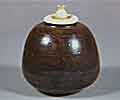In the Nanbouroku, when Rikyuu Kouji held the outdoor chakai at Daizen-ji Temple, he used an shiribukura chaire placed within a chabako, and it is thought that this was the beginning of the chabako. Rikyuu type boxes are made from plain pawlownia. There are various sizes, but Sotan-favoured boxes are done in crimson lacquered ikkanbari. At that time, chabako were also called cha-bentou. Since it is no more than a portable set of tea utensils for making a cup of tea once your destination is reached, it can be used in a sitting room, a garden, or in the wilderness.
In the Spring of Kaei 7, Gengensai the 11th Urasenke head created the Snow, Moon, and Flower procedures on the event of his trip to Ise, which was the start of the modern chabako temae. Tantansai the 14th Urasenke head added the Wakei and Shikishi procedures.
Gengensai, who hoped for procedures that expressed the seasons, after thinking of the Snow, Moon, and Flower temae, created a temae for summer. On an early summer’s evening at Housensai, He noticed the white duetzia blooming the front garden. Thus the summer temae was named the deutzia (unohana) temae. This deutzia temae should also be called the hirademae of the chabako. Since the treatment of the utensils is simple, those who are beginning to learn the chabako should first accustom themselves to it.
With the Wakei temae, Tantansai tried to avoid complicated utensils and simplify the temae, so that anyone can easily enjoy doing this temae. The shikishi temae used an imperial basket(gosho-kago) that was favoured by Enosai the 13th. This temae uses several kobukusa together with a chakin box, which when arranged looks just like stationary (shikishi) scattered across the floor. So this temae was called the shikishi temae.
Translator’s Notes:
*Snow, Moon, Flower (Setsugekka or Yuki-Tsuki-Hana): These natural phenomena are often grouped together, signifying the Winter, Autumn, and Spring respectively.
*Shiribukura: A Chinese chaire which has rounded shoulders and whose body swells (bukura) out towards the bottom (shiri). The one owned by Rikyuu is 2 sun (6 cm) high. The body is 2 sun and 1 bu (6.4cm) to 2 sun 2 bu (6.7cm) in diameter. The mouth is 9 bu (2.7cm) in diameter. The bottom is 9 bu in diameter. The lid is 1 bu (0.3cm) high, the shoulder’s width is 1 bu 5 rin (0.5cm). And it weighs 19 monme (71.3g).
茶箱について
南方録によれば、利休居士が大善寺山で野がけの茶会を催されたとき、尻ぶくらの茶入を茶箱に仕込まれて用いられたことが出ており、おそらくこれが茶箱のはじまりではないかと思われます。
利休形のものは桐木地でできており、大きさはさまざままで宗旦好みは朱塗り一閑張りとされています。
当時、茶弁当などといった呼び方もされているところから、旅先でお茶を一服のめるように点前道具一式を仕組んだ携帯用のものにすぎなかったようで、座敷、庭、野山に用いています。
現在の点前作法は裏千家十一世玄々斎が、嘉永七年の春、伊勢路を旅した折、雪、月、花の点前を創案されたのがはじめで、十四世淡々斎が和敬点前、色紙点前を加えられています。
四季を通じた点前を望まれた玄々斎は、雪月花の点前と、夏に寄せての点前も創案されました。初夏の夕べに抛筌斎でくつろがれているとき前庭に咲く真白な卯の花を見て思いつかれ、夏季の点前を卯の花点前と称されたといわれています。
この卯の花点前は、茶箱の平点前ともいうべきもので、器物の扱いがわかりやすくされており、茶箱を習い始めると誰もがまず習得する点前です。
和敬点前は淡々斎が点前の繁雑を避けて道具も簡略にされ、いつでもどこでも点前ができ誰でもが親しみ楽しめるように創案された点前です。
色紙点前は十三世圓能斎の好まれた御所籠を用いて、淡々斎が創案された点前です。
この点前には古帛紗と茶巾箱を置合わせた道具の配置が、ちょうど色紙を散らしたように見えるところから、色紙点前と名付けられました。
